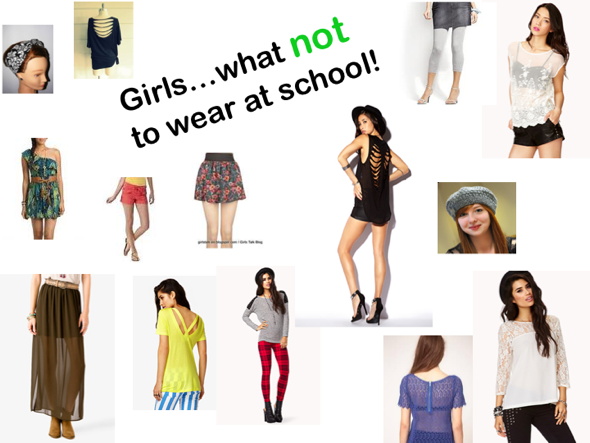Schools tighten grip on restrictive dress codes
– and students are fed up

It’s not just homework that has some young people dreading going back to school. As students file into their classes this month, there’s a whole new world of worry for young people: yoga pants. And shorts. And off-the-shoulder tops, midriff-bearing shirts, and skirts that don’t pass the “fingertip test”.
The list of banned clothing items in high schools seems to get longer every year – and the more restrictive dress codes get, the angrier students grow. This year, hundreds of young women at high schools across the United States are protesting the dress codes nearly as quickly as they are announced.
More than 200 students at Regional Technical high school in Cape Cod, which has banned yoga pants and leggings, have signed up for a Facebook event encouraging people to wear the banned pants on the first day of school.
At Chicago’s McHenry East and West high schools, students have planned a “Show Your Shoulders” protest in response to a dress code that won’t allow students to bare their shoulders.
In Ohio students gathered in opposition to Lakewood high school’s dress code after one girl was disciplined for not wearing a bra.
Restrictive dress code policies are being criticized online as well as on school grounds. In Woodford County, Kentucky, parent Stacie Dunn was shocked to find out that her daughter Stephanie Hughes was called to the principal’s office on the first day of school because she revealed … her collarbones. Dunn took to Facebook to complain, writing: “Parents are being called away from their important jobs and students are missing important class time.” Her post was shared more than 45,000 times.
But it’s not just the dress codes that are problematic the punishment for transgressors has also become increasingly severe.
Last year in New York, over 200 Staten Island students – almost all female – were given detention over dress codes, Florida students were forced to wear “shame suits” when violating the dress code, and earlier this year, schools nationwide came under fire for turning away young women from prom whose outfits were deemed “inappropriate”.
The scourge of unfair dress codes is so great that MTV has published a primer for students on how to tell if their school’s dress code is sexist. One of the clues? If administrators say women’s bodies are “distracting” to learning.
The idea of dress codes to prevent distraction are fairly ubiquitous: the yoga pants ban in Cape Cod was chalked up to not wanting to distract male students, and the same reason was used in Staten Island and most other schools with dress codes that disproportionately target female students. (How “distracted” female students get from their learning experience by being shamed and pulled out of class doesn’t seem to be a concern).
Last year, West Virginia resident Mackenzie Granzow went to school wearing a large hooded sweatshirt and jeans with rips in them. Because one of the rips was above Granzow’s knee, she was removed from class, and Granzow says administrators threatened her with suspension after she refused to change.
“I understood the rule exists,” she said, “but I believe it’s sexist and unnecessary. I told them that if any middle-aged male teacher couldn’t concentrate on teaching because of my clothing, he’s the problem – not me.”
As students fight back in high schools around the country, even younger women – and their parents – may have a battle in front of them as well. Dress codes are starting to affect students as early as first and second grade.
Pete Twiss said, for example, that his eight- and 10-year-old daughters aren’t allowed to wear “spaghetti strap” tops to their school in Tamworth, New Hampshire. “It’s frustrating,” Twiss said, “for the fact that it is just wrong, and also because most clothes marketed to that age group of girls have spaghetti straps.”
But like the teen girls who are taking creative measures to draw attention to the skewed codes, Twiss has an idea of his own: “One day I’d like to organize for all the parents – men and women – to show up at a school event wearing spaghetti strapped dresses and tank tops.”
Article Source: http://www.theguardian.com/education/2015/sep/07/restrictive-school-dress-codes-student-outrage
Image Source: http://ghs.pasco.k12.fl.us/wp-content/uploads/ghs/2011/12/dress_code1.jpg
VOCABULARY WORDS:
1. Bare (adj.) ~ not clothed or covered
2. Collarbone (n.) ~ either of the pair of bones joining the breastbone to the shoulder blades
3. Transgressor (n.) ~ someone who violates a law or command
4. Scourge (n.) ~ a person or thing that causes great trouble or suffering
5. Ubiquitous (adj.) ~ present, appearing, or found everywhere
6. Skewed (adj.) ~ biased or distorted in a way that is regarded as inaccurate, unfair, or misleading
QUESTIONS FOR DISCUSSION:
1. Are there dress codes in middle schools and high schools in your country? Describe what students can and can’t wear in schools.
2. Some students and even parents are against this policy since it mainly focuses on women and they say that it is discrimination. Do you agree or disagree. Discuss your answer.
3. Do you think that the way the students dress, their hairstyle and jewelries/accessories affect their performance in school? Explain your opinion.